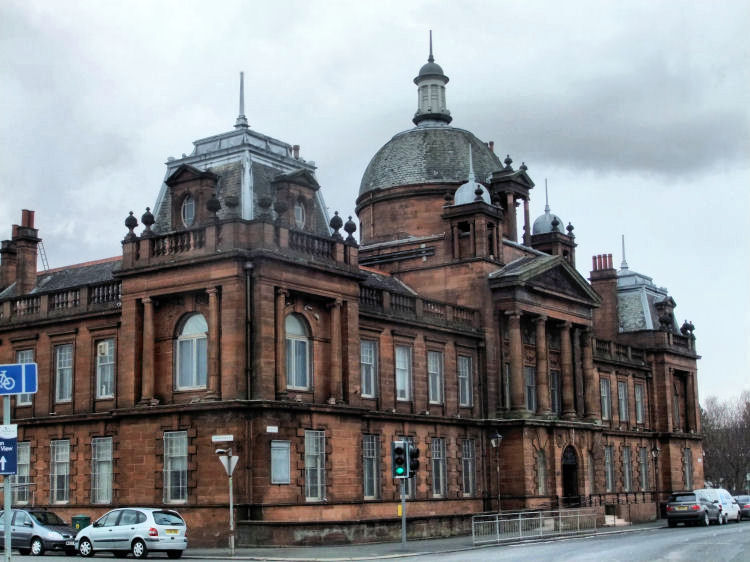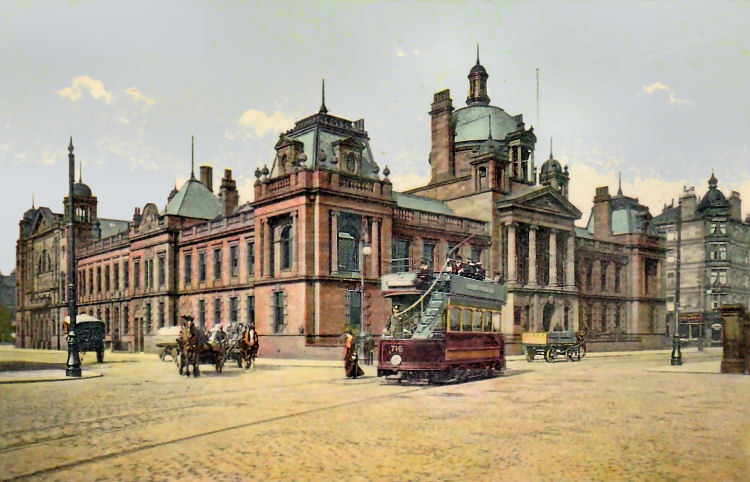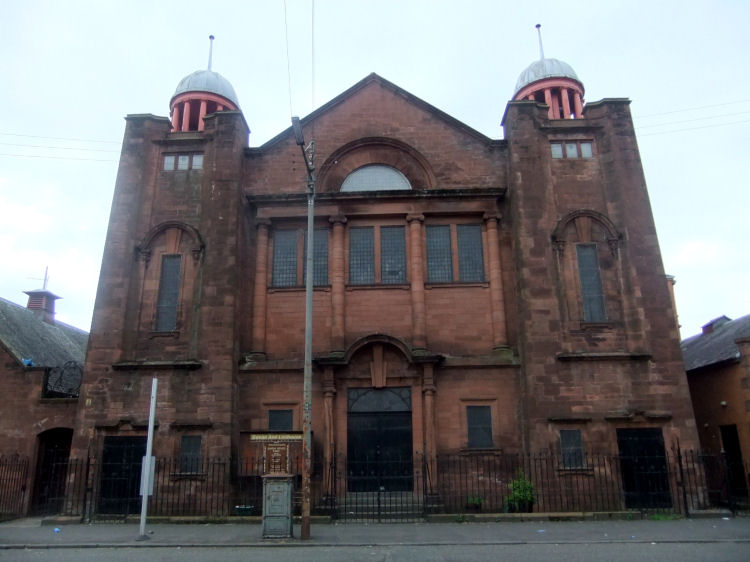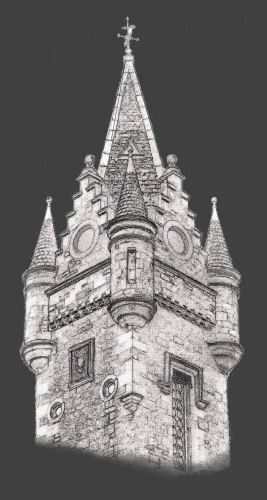

Drawing of dome at Govan Town Hall
Govan originated as part of the ancient Kingdom of Strathclyde where the local language was a form of Cymro-Celtic, related to modern-day Welsh. The terms Gov, Govan, Govant were all used to designate an artist or a smith who prepared metal from raw ore. It has been suggested that the workshops of the early Christian artisans may have given its name to both the village and the parish. Map of the Parish of Govan, 1795
The extracts below were published before the industrialisation of Govan. The first shows the various settlements on the route from Glasgow to Renfrew around the time when the above map was published. Fairfield was occupied by Mr John Cumming and Mavisbank by Mr James Hamilton.
Village of Govan before the arrival of industry
View of Govan from north bank of the Clyde at the mouth of the Kelvin, 1842
The ancient church at Govan was dedicated to St. Constantine who founded a monastery near the Clyde around the same time as St. Columba established his community on Iona. Constantine converted the local population to Christianity and after suffering martyrdom he was buried at his monastery at Govan. Engraving of Govan Church, built 1826
The foundation stone of the present Govan Parish Church was laid by Mrs Isabella Elder on Saturday 6th December 1884. The church, which was designed by Sir Robert Rowand Anderson, was formally opened on Saturday 19th May 1888 with a dedication service attended by noted clergy and dignitaries including the Lord Provost of Glasgow.
Govan Parish Church
Interior of Govan Parish Church
Inside the church there are a number of early mediaeval carved stones from the time when Govan was part of the Kingdom of Strathclyde.
Stone sarcophagus displayed at Govan Parish Church
Some of the early mediaeval stones at Govan Parish Church
Photograph of hogback gravestone in Govan Old Parish graveyard c.1900
The nearby Govan and Linthouse Church was built in 1873. It was designed by Robert Baldie with a simple three-gabled façade and no tower. Govan and Linthouse Church
St Anthony's R.C. Church in Govan Road was designed in the Italian Romanesque style by John Honeyman. The church features a square tower with an open arched belfry. St Anthony's opened on 26 October 1879.
Tower and belfry of St Anthony's Church, Govan
Govan Town Hall
The industrial expansion of Govan and the associated rise in population led to the town and the wider area achieving burgh status in 1864.
Govan Town Hall repaced the original municipal buildings in Orkney Street which became the Police Station. The new hall was designed in the Edwardian Renaissance style by the architectal practice of Thomson & Sandilands and built with red sandstone from Dumfriesshire. It was formally opened in 1901 by James Kirkwood, Govan's Provost. The building contained two public halls and municipal offices with a large suite of rooms for council business.
Exhibition drawing of Govan Town Hall displayed at the Royal Glasgow Institute of the Fine Arts, 1898
Drawing of interior of Govan Town Hall, 1899
Early twentieth century street scene outside Govan Town Hall
Bottom of Copland Road at Govan Road, c.1948
Painting showing distant view of Govan Town Hall from Prince's Dock
Govan is world renowned for its place in the history of modern shipbuilding, which had began on the Clyde as part of the massive industrialisation of Glasgow in the mid-1800's when the railway network was being developed and many novel uses were being found for mass-produced iron. Locally made iron products were used in the construction of bridges, ships, locomotives, mills and factories.
Robert Napier (left) was a pioneer of modern shipbuilding and marine engineering on the Clyde. He built his first successful engine in 1823 and by 1830 he had established extensive mechanical workshops in Finnieston. In 1838 he was appointed as the main supplier of marine engines for vessels procured by the Royal Navy.
As well as being an engineer, Napier was a remarkably successful shipbuilder on the other side of the Clyde at Govan.
One of Napier's most noted associates was John Elder, who went on to establish his own successful business in Govan.
Launch of an iron ship with screw propeller at Napier's Shipyard in Govan, c.1861
'S.S. Scotia', built at Napier's Shipyard in Govan, 1862
The Fairfield Shipyard takes its name from the manor house and associated farm where the final occupier was Mr Alexander Thompson. The development of the yard began in 1864 under the guidance of John Elder a former engineer at Napier's shipyard who is credited with developing an improved compound marine engine.
Aerial view of Fairfield Shipyard, Govan
The shipyard is currently operated by BAE Systems Surface Ships Ltd, one of the world's largest builders of naval warships. The same company own the former Yarrow shipyard on the other side of the river at South Street, Scotstoun. The two yards work together in the fabrication of new vessels, primarily for the Royal Navy.
The Fairfield offices, below, were designed in 1890 by John Keppie, the future mentor of Charles Rennie Mackintosh. The offices served their original purpose until 2001 when they became unoccupied and gradually fell into a state of disrepair.
Offices at Fairfield Shipyard, Govan
Railway wagons on tram track at Fairfield Shipyard, Govan
HMS Nelson, built at Fairfield Shipyard and launched on 4th November 1876
RMS Empress of Britain, built at Fairfield Shipyard and launched on 11 November 1905
Statue of John Elder with his compound marine engine
The statue stands in beautifully landscaped Elder Park, facing Fairfield Shipyard, which was gifted to the people of Govan by Mrs Isabella Elder, the widow of the famous engineer and shipbuilder. Mrs Elder also provided the library at the corner of the park which pre-dates Glasgow's fine Carnegie Libraries, and is featured in my Andrew Carnegie page. Carnegie never visited any of the libraries he funded in the city but paridoxically he performed the official opening of Elder Park Library on 5th September 1903.
Early 20th century view of Elder Park with small children surrounding statue of John Elder
These kissing “lovebirds” were created by sculptor Helen Denerly in 1994 to sit outside the Fairfield Shipyard gates. The birds are cormorants, which can often be found sitting about the Clyde at Govan.
Sculpture of cormorants in Govan
This proud cormorant was spotted in the Clyde near the Govan Town Hall, sitting on a buoy in midstream of the river.
The Pearce Institute opened in 1906, providing community halls and recreation rooms to the people of Govan. It was designed in the popular Edwardian Renaissance style by Sir Robert Rowand Anderson . The façade is richly decorated with sculpture, topped by a model of a fully-rigged galleon. Pearce Institute and statue of Sir William Pearce
Edwardian sketch of Pearce Institute, Govan
Traffic policeman on points duty at Govan Cross, 1955
The Aitken Memorial Fountain was first placed at Govan Cross in 1884. It commemorates the contribution to the health and welfare of the local population by Dr. John Aitken, who served as the Police Surgeon and Medical Officer to the Burgh of Govan from 1864 until his death in 1880.
Aitken Memorial Fountain, Govan Cross
Early 20th century view of YMCA and Post Office at Govan Cross, with Aitken Memorial Fountain in background
Early 20th century view of Govan & Linthouse Church and Aitken Memorial Fountain
Busy scene at Govan Cross, 1955
Old view of entrance to Govan Cross Subway Station and Watson's Bar, Greenhaugh Street
The MV Second Snark has been operating as a ferry between Govan and Yorkhill Quay since August 2011.
The MV Second Snark and the SV Glenlee
A fully illustrated history of the Clyde ferries in Glasgow is included in my Clyde Ferries, Cluthas & Docks page.
Govan Ferry crossing a very busy River Clyde, 1832
Victorian view of Govan Ferry looking west towards setting sun
Govan Ferry Terminal, Water Row c.1900
Street scene at Water Row, Govan, c.1900
Old cottages at Water Row, Govan
Elder Cottage Hospital, which opened in 1902, was designed in the Edwardian Renaissance style by J J Burnet. It was originally intended to be a maternity home, hence the relief of a mother nursing her baby over the main entrance of the building.
Elder Cottage Hospital
Linthouse Mansion was designed by Robert Adam and built in 1791.
In 1869 the house and surrounding estate were acquired by shipbuilders Alexander Stephen & Sons,
who established their shipyard there. The house was used for the company's offices until it was demolished in 1921. The portico was preserved and re-erected in Elder Park.
Linthouse Mansion
Linthouse St Kenneth Church was originally built for the United Free Church. It was designed by architect James Miller and opened in 1900.
Linthouse St Kenneth Church
The mansion house of Shield Hall was built c 1720 and was acquired by the Scottish Wholesale Co-operative Society in the late 1880s.
The house was demolished and the surrounding estate was used by the SCWS for their factories and warehouses.
The mansion gave its name to the present day district of Shieldhall.
Shield Hall Mansion
The original buildings of the Southern General Hospital were part of the Govan Combination Poorhouse which was built on the Merryflats Estate in Shieldhall in 1872.
On 26th July 1872 the inmates of the old poorhouse and asylum were moved to the new establishment, which had been built for the parishes of Govan and Gorbals at a cost of £100,000. Much of the finance came from the railway companies who had bought the old site. The new poorhouse had accommodation for over 700 destitute people and the asylum for over 200 patients, described in the unsentimental language of the time as “paupers” and “lunatics”.
Map showing main entrance to Govan Poorhouse
Entrance to Govan Combination Poorhouse, designed by James Thomson
Clock tower at Southern General Hospital
The most spectacular example of modernistic architecture in Govan is the refurbished Luma Building in Shieldhall Road.
The former Luma Lamp Factory was built in 1938 in the fashionable Art Deco style of the time.
Art Deco tower of the Luma Building
Wild flowers on the riverside in "Sunny Govan"

The parish of Govan was separated from the Barony parish of Glasgow by the River Kelvin on the west. It lay on both sides of the Clyde and extended as far as Gorbals on the south side of the river. "Little Govan" and "Butterbiggins" in the south east corner of this 1795 map now form part of the district of Govanhill.
There are many manor houses surrounding the old village of Govan which later became associated with local place names. The houses at Fairfield, Linthouse and Broomloan are all shown in the map along with many other familiar names.

The later extract describes Govan and the surrounding areas shortly before its enormous expansion. It's not too complimentary about the older parts of the town. The reference to "Culdee times" goes back to the age of the monastic communities of the early Celtic church.




There have been a number of different church buildings at Govan since the foundation of the first church by St Constantine in 565 AD. The last mediaeval church was replaced by a new church in 1762, which in turn was replaced by the church shown in the engraving, below, which was built in 1826. This church was designed by architect James Smith who modelled the tower and spire from the church at Stratford-upon-Avon.



The highlight of the display is an ornate solid stone sarcophagus. There are also "hogback" burial stones and the intricately carved remnants of ancient crosses. Some of the stones feature carvings with Scandanavian influences, reflecting the Viking presence in the area from around the middle of the ninth century.



The church has had numerous identities over the years. Originally named as St Mary Govan Free Church, it became St. Mary’s Church of Scotland in September 1929 after the union of the denominations. In 1975 the church became St. Mary’s Fairfield following a merger with Fairfield Church of Scotland. A further union took place in April 1982 when Govan Trinity joined and it became New Govan Church of Scotland.
It acquired the title of Govan and Linthouse Church following the amalgamation of the congregations of Govan Old, Linthouse and New Govan churches in 2008.




The burgh's first Provost was Morris Pollock who led the earliest council (left), which had nine Commissioners and two magistrates.
Govan became part of the City of Glasgow in 1912 along with the nearby burghs of Partick and Pollokshaws. Govan Town Hall lost its administrative function and became just another one of the city's many public halls.






In 1841 he took over a small old-fashioned shipyard at Govan and reconstructed it as a facility specially designed to build iron ships. Napier's yards contained the slipways from where numerous warships, cargo vessels and ocean-going liners were launched.
The iron plates and machine parts for the ships and their boilers were manufactured at the Parkhead Forge, where Napier would take outright control in 1848.


When Elder died in 1869 the equally famous William Pearce took over the management of the yard which expanded to become the biggest shipyard in the world before the inevitable decline of the late twentieth century.

Govan Workspace purchased the building in 2009 and have carried out emergency repairs in preparation for ongoing refurbishment.
Plans have been prepared for the creation of the "Fairfield Heritage Centre" as a visitor attraction within the office block.






The cormorants were constructed with steel bolts, chain links and other bits-and-pieces recovered from the shipyard.


The institute was gifted to the people of Govan by Lady Dinah Elizabeth Pearce, the widow of Sir William Pearce, who had become the manager of the Fairfield Shipyard in 1869 and its sole owner in 1878. Pearce retired from business after the 1885 general election when he had become the first Member of Parliament for the new Govan constituency. In 1894 a statue by Onslow Ford was erected in honour of Sir William, who had died 6 years earlier in 1888.



Over the years the fountain had been allowed to deteriorate, but in 2011 a full refurbishment of the decaying ironwork restored it to provide the beautiful landmark shown below.
The fountain is the only surviving example of the elaborate cast-iron drinking fountains produced at the Denny Works of Cruikshanks & Co.





In the view of the ferry, below, you can get a glimpse over the river to the Tall Ship SV Glenlee at the Riverside Museum.










The institution was built as a replacement for the Govan Poorhouse in Eglinton Street, Gorbals, which had to be removed to make way for the new railway track and station buildings needed for the expansion of the approaches to the proposed Glasgow Central Station. A "before & after" view of the development of the railway is featured in my Eglinton Street Station page.
New hospital blocks were added in the 1880's and 1890's and a nurses home was built in the surrounding grounds in 1905. There was further expansion throughout the twentieth century to create the complex with which we are now familiar.




In 1997 the building was extended and converted to form an apartment block with an internal courtyard behind the landmark tower. Three new blocks were built in marching style to the rear of the original building.


![]()
 |
| |
|
|
||
|
|
||
|
|
All original artwork, photography and text © Gerald Blaikie
Unauthorised reproduction of any image on this website is not permitted.